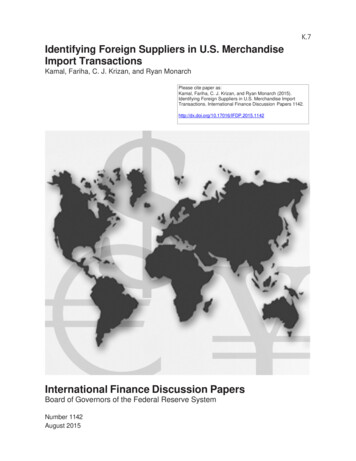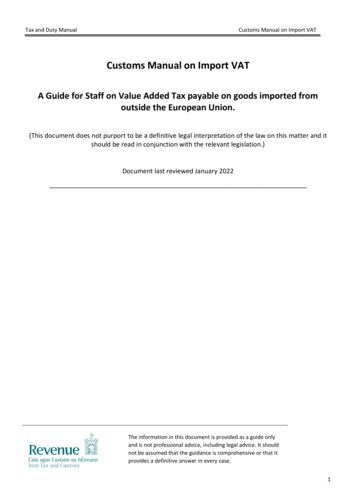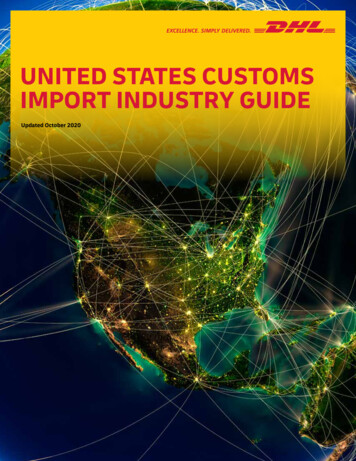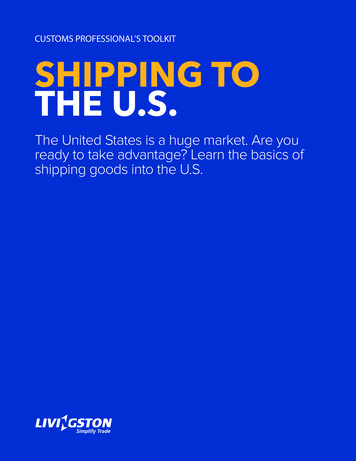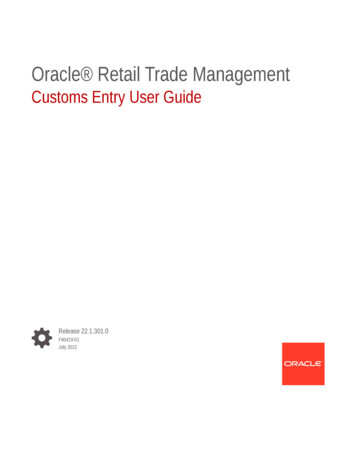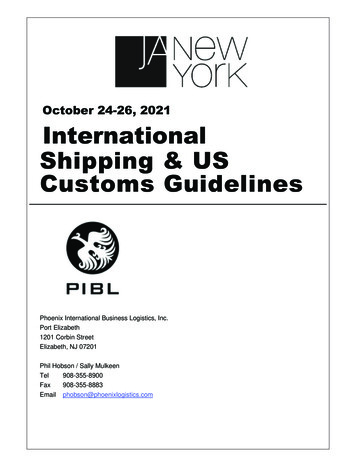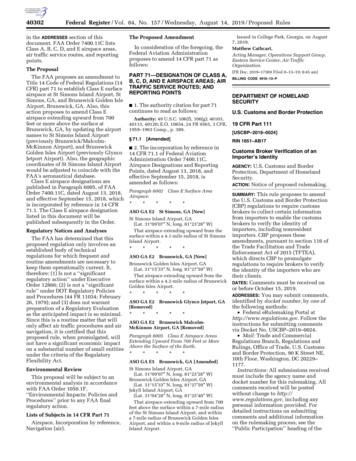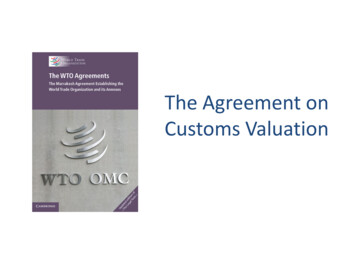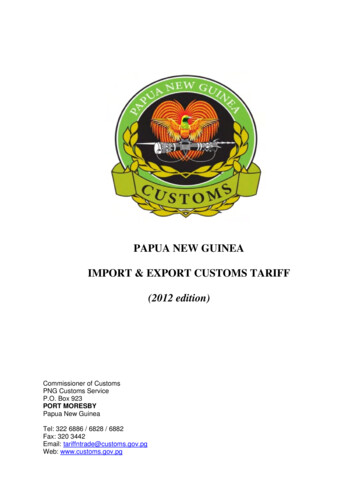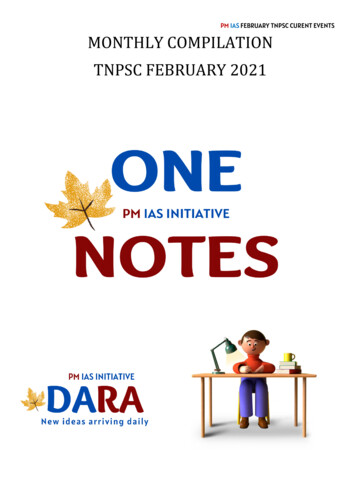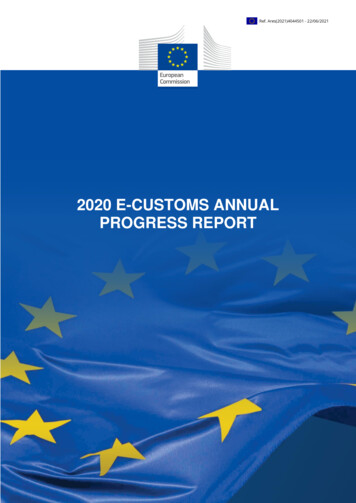
Transcription
Ref. Ares(2021)4044501 - 22/06/20212020 E-CUSTOMS ANNUALPROGRESS REPORT
2020 E-CUSTOMS ANNUAL PROGRESS REPORTEUROPEAN COMMISSIONDirectorate-General for Taxation and Customs UnionDirectorate B — Digital delivery of Customs and Taxation PoliciesUnit B1. — Processes & data, customer relationship and planningE-mail: TAXUD-E-CUSTOMS@ec.europa.euEuropean CommissionB-1049 BrusselsLEGAL NOTICEThis document has been prepared for the European Commission however it reflects the views only of the authors, andthe European Commission is not liable for any consequence stemming from the reuse of this publication. Moreinformation on the European Union is available on the Internet (http://www.europa.eu).PDFISBN -N European Union, 2021The reuse policy of European Commission documents is implemented by the Commission Decision 2011/833/EU of 12December 2011 on the reuse of Commission documents (OJ L 330, 14.12.2011, p. 39). Except otherwise noted, thereuse of this document is authorised under a Creative Commons Attribution 4.0 International (CC-BY 4.0) 0/). This means that reuse is allowed provided appropriate credit is givenand any changes are indicated.For any use or reproduction of elements that are not owned by the European Union, permission may need to be 2021 Page 2 of 107
2020 E-CUSTOMS ANNUAL PROGRESS REPORTTable of ContentsTABLE OF FIGURES. 5LIST OF TABLES . 51.OVERVIEW OF E-CUSTOMS PROGRESS PERFORMANCE . 62.INTRODUCTION . 103.BACKGROUND . 103.13.23.33.44.E-CUSTOMS KEY MILESTONES AND ACHIEVEMENTS IN 2020 . ustoms Initiative . 10Tasks and Coordination . 10Governance of the e-Customs Implementation . 10The Commission’s and Member States’ Responsibilities . 11Union Customs Code (UCC) and core legislative framework . 11Revision of Annex B to the UCC DA and UCC IA and ChangeManagement . 14EU Single Window Environment for Customs (EU SWE-C) . 15Preparation Activities for UK Withdrawal from the EU . 17e-Customs Governance . 18Customs IT Collaboration . 20e-Customs Project Groups . 21Supporting Instruments. 24IT Modernisation . 27IT Business Continuity Management System (IT BCMS) . 29Service Level Agreement (SLA) and Terms of Collaboration (ToC) . 32Innovative Technology Solutions . 33The Recovery and Resilience Facility . 34COSTS . 355.15.2Costs incurred by DG TAXUD on IT systems development in 2020 . 35Costs incurred by the Member States in 2020 . 37ANNEX 1 – IT SYSTEMS PROGRESS ACTIVITIES . 451MASP-C PROJECTS . 461.130/06/2021 MASP-C Group 1 - Customs European Information Systems . 461.1.1UCC Customs Decisions (1.2). 461.1.2UCC Binding Tariff Information (UCC BTI) (1.4) . 481.1.3UCC AEO and impacts of MRA (1.5). 481.1.4UCC Automated Export System (AES) (1.6) . 491.1.5UCC Transit System including NCTS (1.7) . 511.1.6UCC Registered Exporter System (REX) (1.11) . 521.1.7COPIS (1.12) . 531.1.8EU Single Window environment for customs (EU SWE-C)(1.13) . 541.1.9Classification Information System (CLASS) (1.14) . 56 Page 3 of 107
2020 E-CUSTOMS ANNUAL PROGRESS REPORT1.1.101.21.31.41.51.6UCC Economic Operators Registration and Identificationsubsystem 2 (EORI2) (1.15) . 561.1.11 Customs Risk Management System2 (CRMS2) (1.16) . 571.1.12 e-Commerce and CP 42/63 (1.17) . 571.1.13 Import of Cultural Goods (1.18) . 581.1.14 UCC Import Control System2 (ICS2) (1.19). 591.1.15 UCC Surveillance3 (1.20). 61MASP-C Group 2 - Customs European initiatives needing furtherstudy and agreement . 621.2.1UCC Notification of Arrival, Presentation Notification andTemporary Storage (2.1) . 621.2.2UCC Guarantee Management (GUM) (2.5) . 631.2.3UCC Special Procedures (2.6) . 641.2.4Adjustments of the existing import applications under theUCC (2.10) . 651.2.5Customs Union Performance – Management InformationSystem (CUP-MIS) (2.11) . 671.2.6UCC Proof of Union Status (PoUS) (2.12) . 681.2.7European Maritime Single Window environment (EMSWe)in relation to customs systems (2.13) . 69MASP-C Group 3 - Customs International Information Systems . 701.3.1EU Implementation of UNECE eTIR System (3.1) . 701.3.2eATA Carnet Project (3.2) . 701.3.3Smart and Secure Trade Lanes (SSTL) (3.3) . 71MASP-C Group 4 - Customs IT cooperation initiatives andtechnological developments to facilitate Customs EIS (includingcurrent CCN operations) . 721.4.1National Systems Implementation by IT CollaborationProjects (4.1). 721.4.2Common Communication Network2 (CCN2) (4.5) . 721.4.3UCC Uniform User Management and Digital Signatures(UUM&DS) – Direct Trader Access to EIS (4.6) . 741.4.4High Availability DG TAXUD operational capabilities (4.7) . 751.4.5Maintenance and Updates of Operational IT systems (4.8) . 761.4.6IT Business Continuity (4.9) . 78Other National Projects and Activities . 79Supporting activities . 801.6.1Supporting tools used for collaboration and communicationbetween EU and EU Member State administrations . 801.6.2Consultations with economic operators . 811.6.3Training for Customs officials and other stakeholders . 821.6.4Promotion and other activities . 871.6.5Coordination of e-Customs with other e-Governmentsystems or activities . 89ANNEX 2 – PLANNING OVERVIEW OF MASP-C PROJECTS . 93Explanatory Note on the Planning Overview of MASP-C Projects . 93ANNEX 3 – ACRONYMS, ABBREVIATIONS & KEY TERMS . 9830/06/2021 Page 4 of 107
2020 E-CUSTOMS ANNUAL PROGRESS REPORTTable of FiguresFigure 1: DG TAXUD UCC IT Implementation progress . 8Figure 2: Commission and Member States’ total expenditure on IT Development andMaintenance in 2020 . 9Figure 3: Commission and Member States’ grand total on e-Customs activities in 20192020 . 9Figure 4: Professionals trained with EU eLearning portfolio . 26Figure 5: Distribution of EU eLearning portfolio at national level . 27Figure 6: Evolution of CCN message quantities/volume . 30Figure 7: System message evolution . 31Figure 8: CCN messages distribution per system application . 31Figure 9: Commission’s costs in year 2020 (expressed in ). 36Figure 10: Main categories of the Commission costs in year 2020 . 37Figure 11: Commissions’ costs for customs IT systems, 2008-2020 . 37Figure 12: Member States’ costs of customs IT systems in 2020 . 38Figure 13: Costs on IT systems in Operation and in Development as part of all systemsin 2020 . 39Figure 14: Cost per MASP-C Revision 2019 Project Groups. 40Figure 15: Distribution of Member States’ expenditure . 41Figure 16: Member States’ costs, 2008-2020 . 42Figure 17: Average Member States' costs, 2008-2020 . 42Figure 18: Total costs over the years 2008-2020 for 7 MS that reported in all years . 43Figure 19: Member States’ man-hours for Customs IT systems in 2020 . 44Figure 20: Member States’ man-hours consumed in 2020 . 45Figure 21: NCTS - Volume of movements and error rate per year since 2012 . 77Figure 22: ECS – Evolution of movements and error rate per year since 2012 . 77Figure 23: ICS – Evolution of number of movements and error rate per year since 2012. 78Figure 24: Evolution of number of Customs trainees in national administrations . 83Figure 25: Number of trainees for the UCC eLearning Programme 2019-2020 . 85List of TablesTable 1: Abbreviations and acronyms . 10530/06/2021 Page 5 of 107
2020 E-CUSTOMS ANNUAL PROGRESS REPORT1.OVERVIEW OF E-CUSTOMS PROGRESS PERFORMANCE1During the course of 2020, the Commission achieved several fundamental milestonesrelated to the successful implementation of the ongoing e-Customs reform. Thetransition to a paperless environment is a priority for the Member States and theCommission, a commitment reflected in the completion of several legislative, business,IT and operational activities in the e-Customs domain.In 2020, the Commission continued amending the existing legislation and introducingadditional measures to strengthen the e-Customs framework for a modern CustomsUnion. Preparations for amendments to both the UCC DA and UCC IA were made withthe objective to harmonise the common data requirements of the electronic customssystems across all Member States. Notably, the amendment to the UCC DA, whichwas adopted on 7 December 2020, introduced the revised Annex B, thus ensuringthe alignment between the legal provisions relating to the data requirements and thefunctional and technical specifications for the trans-European systems. An additionalamendment was drafted concerning the Implementing Regulation (EU) 2019/1026,which covers technical arrangements for the information exchange through the UCCUUM&DS, UCC CDS, UCC BTI, UCC EORI and UCC AEO projects. In particular, theproposed amendment, which was thoroughly discussed during 2020, extends thescope of the regulation to cover the following projects: UCC ICS2, UCC AES, UCCNCTS (Phase 5), UCC INF, UCC CCI, EU CTP and CRMS. In parallel, theCommission delivered on 14 December 2020 the second annual UCC progressreport, in pursuance of Article 278a of the UCC. As indicated in the report, tangibleprogress was achieved notwithstanding the challenges posed by the COVID-19pandemic outbreak.In 2020, DG TAXUD in collaboration with JRC continued the analysis of the ForesightStudy on the Future of Customs in the EU for the 2040 horizon which was launched in2019 and was designed as a structured process to better comprehend the trends anddrivers impacting the EU Customs and to gather collective intelligence for the long-termfuture. As a result, the “Future of Customs in the EU 2040” was published by theCommission’s JRC on 10 December 2020. The study envisaged how the world mightlook by 2040, and how policymakers can take actions now to ensure the EU CustomsUnion continues to benefit citizens, the environment, and the economy. The findings ofthe foresight process fed into the Commission’s Customs Action Plan launched on28 September 2020, which puts forward a vision and a plan of ambitious actions totake the Customs Union to the next level.A significant contribution to the implementation of the e-Customs framework and theoverall modernisation of the customs domain is the EU Single Window Environment forcustoms. A trade facilitation measure, the EU SWE-C also intends to meet theCommission’s commitment for a digitalised approach to EU customs controls.Following the preparation of the draft impact assessment, the Commission’sRegulatory Scrutiny Board (RSB) adopted the report on 15 July 2020, paving theway towards the preparation of a pertinent legislative proposal. The legislative proposalforesees the development of the EU SWE-C on the basis of a twofold digitaladministrative cooperation (G2G and B2G), promoting collaboration between customsand partner competent authorities, and at the same time, enhancing trade facilitation inthe EU. The legislative proposal was included in the Customs Action Plan and on 28October 2020 it was adopted by the College of Commissioners.1From a timeline perspective, the information of the report reflects the author’s perspective on 1 January2021.30/06/2021 Page 6 of 107
2020 E-CUSTOMS ANNUAL PROGRESS REPORTIn view of the impending UK withdrawal from the EU on 31 December 2020, asstipulated in the Withdrawal Agreement, the Commission continued the transformationand the preparation of the customs systems in alignment with the legal requirementsprovided for in the UCC and the IE/NI Protocol. Numerous activities were conductedwith the participation of the Member States as well as economic operators to ensure asuccessful and smooth transition.Cooperation between the Member States, the Commission and the economic operatorsthrough a range of specialised project groups remained a key area of activity in 2020despite the constraints imposed by the COVID-19 crisis. Active project groupscontinued to impel progress on the UCC CDS, UCC CCI, UCC ICS2, UCC NCTSPhase 5 and UCC AES, UCC PoUS and Import of Cultural Goods. A new project groupon the UCC INF SP system was launched in 2020 in view of the anticipateddeployment of the system, aiming to further analyse the business functionalities of thesystem. Notable progress was accomplished in the scope of customs IT collaborationthrough the activities of the ETCIT group. Following the establishment of ETCIT I in2018, the second expert team ETCIT II was established, focusing on further expandingthe collaborative ways of delivering customs IT in the future, aiming to increase theefficiency and quality of the Customs IT delivery and operations for strategiccollaboration post 2025. An extension of the work under a third phase is considerednecessary and useful in order to take the possibilities of IT collaboration further.2020 was a very active year as concerns the MASP-C projects progress. Substantialefforts were invested in the implementation of various systems. In particular, the UCCINF SP, CCN2ng Release 1.1 and CCN2ng Release 1.2, UUM&DS Release 2 for ICS2and COPIS eAFA, REX2 v2.4 OCTs, EU CSW-CERTEX (CHED-PP, CHED-D, ODS),e-Commerce & CP 42/63, UCC CDS v1.24 and CLASS (corrections) entered intooperations. The systems deployed were AES Central convertor application Release1.0, UCC INF SP, UUM&DS Release 2 for ICS2 and COPIS eAFA and EU CSWCERTEX (CHED-PP, CHED-D, ODS). The systems that received “go decision” wereUCC ICS2 Release 2, UCC CCI Phase 2, UCC REX3, EU CSW CERTEX Dual Useand UCC PoUs Phase 1 T2L/T2LF. In addition, conformance testing was performed forUCC ICS2 Release 1, while for the UCC AES and UCC NCTS Phase 5 projects thecompletion date is foreseen in 2021. Equally important activities were the creation ofthe Business Cases for the Import of Cultural Goods (ICG), UNECE eTIR and UCCGUM, as well as the Vision Documents for ICS2 Release 2, UCC CCI Phase 2, UCCREX3, EU CSW CERTEX Dual Use, UCC PoUs Phase1 T2L/T2LF and UCC PoUSPhase 2 CGM. An overview of the MASP-C projects progress can be found inAnnex 2.Figure 1 below depicts the evolution of the UCC IT Implementation progress by theCommission, notably by DG TAXUD B since 2016. The initial development of the UCCIT implementation was planned to be completed in 2020 based on the MASP 2016.However, it was considered to be a very ambitious planning resulting in a re-evaluationduring MASP 2017 and MASP-C Revision 2019 with a more realistic approach of the ITimplementation of the systems. A significant progress of 79% of the total UCC ITimplementation has been reached in 2020 by DG TAXUD.30/06/2021 Page 7 of 107
2020 E-CUSTOMS ANNUAL PROGRESS REPORTFigure 1: DG TAXUD UCC IT Implementation progressAs the e-Customs environment continues to develop and entails greaterresponsibilities, the Member States and the Commission face an evolving set ofchallenges in relation to e-Customs implementation. The effective identification,preparation and management of these challenges remains a high priority. To this end,the Commission launched an IT modernisation programme focusing on theenhancement of the IT service provided to the Member States through five tracks,addressing different IT related objectives. In addition, business continuity remained acore objective of the Commission. In 2020, several business continuity measures wereadopted, and activities were conducted, the most notable being the initiation of PhaseIII of the IT BCMS Revamping project. Among the main objectives pursued by theproject is the implementation of the necessary requirements in order to be able tosupport the new Gold service level. The deployment of new electronic systems andthe continuous evolution of the existing ones has also led to the update of the ServiceLevel Agreement and Terms of Collaboration documents by the Commission. Driven bythe need to further align these documents with the MASP-C Revision 2019, they werevalidated and accepted by all Member States in summer 2020.Furthermore, following the COVID-19 pandemic outbreak and in view of the substantialimpact the pandemic exerted on the EU societies and economies, the Commission,the Parliament and the EU leaders agreed on the creation of the Recovery andResilience Facility. Under this temporary financial instrument, the Member States canreceive financial support to help them mitigate the economic repercussions of thepandemic and to lay the ground for a more sustainable EU.It is evident that the emerging challenges cover a wide scope of topics, including thestrengthening of controls to tackle fraud and security risks, the need for greatermonitoring of the EU customs legislation, the imperative of improving efficiency,harnessing innovation and continuing to work with international partners in the field ofcustoms. The e-Customs reform remains a dynamic process as the Commissioncontinues to consolidate a new legal framework for the Customs Union with newworking methods and IT tools, in partnership with the Member States.In line with this commitment, the Member States and the Commission allocated asignificant number of resources to e-Customs activities, both in terms of personnel andof investments. Figure 2 depicts the 2020 budget dedicated by the Member States andthe Commission, showing that similar to 2019 and 2018, the new IT systemdevelopment remained the core focus, recording more than two-thirds of their30/06/2021 Page 8 of 107
2020 E-CUSTOMS ANNUAL PROGRESS REPORToverall combined budget. The remaining one-third of combined expenditure wasdedicated to maintenance activities.Figure 2: Commission and Member States’ total expenditure on IT Development andMaintenance in 2020Lastly, Figure 3 shows the combined cost during 2020 by the Member States and theCommission increased by 13.77% relative to the previous year. The total amountdedicated to e-Customs activities in 2020 was 245,291,612.32 .Figure 3: Commission and Member States’ grand total on e-Customs activities in 2019202030/06/2021 Page 9 of 107
2020 E-CUSTOMS ANNUAL PROGRESS REPORT2.INTRODUCTIONThe 2020 e-Customs annual progress report is the thirteenth report prepared pursuantto Article 12 of the e-Customs Decision (Decision 70/2008/EC)2, under which theMember States are required to assess the progress made towards coordinating theimplementation of the e-Customs initiative. The Commission3 prepares acomprehensive report covering the annual operational (from a technical viewpoint) andfinancial strategic goals of the Member States within the scope of the e-Customsprojects and supporting initiatives.This year the Commission received 26 national e-Customs progress reports.3.BACKGROUND3.1 e-Customs InitiativeIn 2003, the Commission issued an e-Customs Communication4 that containedproposals about a new simplified paperless environment for customs and trade. The eCustoms Communication carved out an important path towards radically simplifyingcustoms regulations and procedures and integrating modern, efficient and uniformtechniques within the EU Customs Union. The subsequent 2003 Council Resolution 5endorsed the objectives formulated in the e-Customs Communication, thus establishingthe framework for the e-Customs initiative. Decision 70/2008/EC6 on a paperlessenvironment for customs and trade, also referred to as the e-Customs Decision, is thekey legislation related to the e-Customs initiative, promoting a shift to an interoperableelectronic customs environment with a unified data system to facilitate communicationbetween economic operators and customs authorities and to enhance security at EU’sexternal borders.3.2 Tasks and CoordinationArticles 5, 6 and 7 of the e-Customs Decision define the main components of the eCustoms systems and regulate the cooperation between the Member States and theCommission by specifying the tasks of both stakeholders for the development and thesynchronised implementation of IT projects.3.3 Governance of the e-Customs ImplementationArticle 8(2) of the e-Customs Decision provides that the Member States and theCommission should jointly establish a Multi-Annual Strategic Plan for Customs (MASP-2Decision No 70/2008/EC of the European Parliament and of the Council of 15/01/2008 on a paperless environment s://eur-lex.europa.eu/legalcontent/EN/TXT/?uri celex%3A32008D0070%2801%29.3The European Commission is referred as ‘the Commission’ throughout the document.4Communication from the Commission to the Council, the European Parliament and the European Economic and SocialCommittee - A simple and paperless environment for customs and trade /COM/2003/0452 final, https://eurlex.europa.eu/legal-content/EN/ALL/?uri CELEX%3A52003DC0452%2801%29.5Council Resolution of 05/12/2003 on creating a simple and paperless environment for customs and trade, OJ C egalcontent/EN/TXT/?qid 1591292437326&uri CELEX:32003G1216(01).6Decision No 70/2008/EC of the European Parliament and of the Council of 15/01/2008 on a paperless environment s://eur-lex.europa.eu/legalcontent/EN/TXT/?uri celex%3A32008D0070%2801%29.30/06/2021 Page 10 of 107
2020 E-CUSTOMS ANNUAL PROGRESS REPORTC)7 to ensure the effective management and coordination of all activities and tasksrelated to ongoing and future e-Customs projects. As an overall project managementand planning tool, the MASP-C lays out the strategic framework and milestones for theimplementation of the e-Customs initiative. It is an essential instrument for ensuring asmooth and coordinated implementation of all e-Customs IT projects, while reflecting adetailed operational planning. This implementation is based on a three-tier governancemodel, which consists of the Customs Policy Group (CPG) acting as a steering body atthe policy level, the Electronic Customs Coordination Group (ECCG) at thecoordination level and several groups consisting of specialists from the Member Stateadministrations at the expertise level. The objective of this governance scheme is toenhance transparency and coordination among all stakeholders.3.4 The Commission’s and Member States’ ResponsibilitiesThe Member States and the Commission equally share the responsibility of facilitatingthe customs communication and information exchange systems by coordinating thesetup, deployment and operation of the electronic systems at both European Union andnational level.4.E-CUSTOMS KEY MILESTONESAND ACHIEVEMENTS IN 20204.1 Union Customs Code (UCC) and core legislative frameworkIn 2020, the EU Customs Union remained a unique example, where all EU MemberStates work together as one by applying a uniform legislative framework for handlingthe import, export and transit of goods. The Commission continued to fulfil an activerole in optimising the customs legal framework and procedures to meet the demand ofincreasing trade flows, new business models, and a constantly evolving technologicalenvironment. In this climate, where significant changes are needed, the emphasis ofthe EU customs modernisation over the last two decades shifted away from traditionalbusiness processes, towards the creation of a paperless environment for customsbased on electronic exchange. In pursuit of this goal, in 2012 the Commission outlineda course of action for a more robust and unified Customs Union by 2020. Following theimpact of the substantial legal changes introduced by the Treaty of Lisbon8, the UCC9was adopted in October 2013. The UCC serves as the legal basis for a modern andelectronic customs environment, allowing for an enhanced level of uniformity,efficiency, and communication between the economic operators and customsadministrations.The UCC legislation consists of a package of legal acts laying out requirements for thecomprehensive functioning of the EU Customs Union. During the elaboration of thislegislation, the Commission, national customs administrations and economic operatorsprovided valuable contributions through consultations related to the development of the7Since 2018, the Multi-Annual Strategic Plan is abbreviated as MASP-C, with the suffix of ‘C’ denoting the specific focuson customs IT systems. This change is due to the elaboration in parallel of a MASP-T for taxation IT systems. Alignmentbetween MASP-C and MASP-T will facilitate a more coherent approach to the implementation of IT systems where thecustoms and taxation domains interact. Due to this transition, MASP-C and other variations referring to the MASPframework are used interchangeably. The MASP-C Revision 2019 v1.1 serves as the baseline for this report.Nonetheless, its predecessor, MASP Rev. 2017 v1.4 remains a fundamental reference point for the implementationplanning of e-Customs projects.8Treaty of Lisbon amending the Treaty on European Union and the Treaty Establishing the European Community, ropa.eu/legalcontent/EN/ALL/?uri OJ%3AC%3A2007%3A306%3ATOC.9Regulation (EU) No 952/2013 of the European Parliament and of the Council of 09/10/2013 laying down the ://eur
2020 E-CUSTOMS ANNUAL PROGRESS REPORT 30/06/2021 Page 2 of 107 EUROPEAN COMMISSION Directorate-General for Taxation and Customs Union Directorate B — Digital delivery of Customs and Taxation Policies Unit B1. — Processes & data, customer relationship and planning E-mail: TAXUD-E-CUSTOMS@ec.europa.eu European Commission B-1049 Brussels
